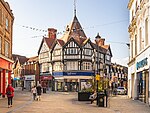Old Library, Wrexham
1907 establishments in WalesBuildings and structures in WrexhamCarnegie libraries in WalesFormer library buildings in WalesGrade II listed buildings in Wrexham County Borough ... and 4 more
Grade II listed library buildingsLibraries in WalesLibrary buildings completed in 1907Use British English from May 2023

The Old Library (sometimes Old Carnegie Library) is a building on Queens Square in Wrexham city centre, Wales. Built as a carnegie library in 1907, the building served as Wrexham's public library until 1973, when it later became council offices. The building is Grade II listed and council-owned, although Wrexham Council announced it plans to sell the building from 2020, and has yet to find a new occupant.
Excerpt from the Wikipedia article Old Library, Wrexham (License: CC BY-SA 3.0, Authors, Images).Old Library, Wrexham
Queens Square, Wrexham City Centre
Geographical coordinates (GPS) Address Nearby Places Show on map
Geographical coordinates (GPS)
| Latitude | Longitude |
|---|---|
| N 53.047014 ° | E -2.993582 ° |
Address
Queens Square
LL11 1AP Wrexham, City Centre
Wales, United Kingdom
Open on Google Maps










